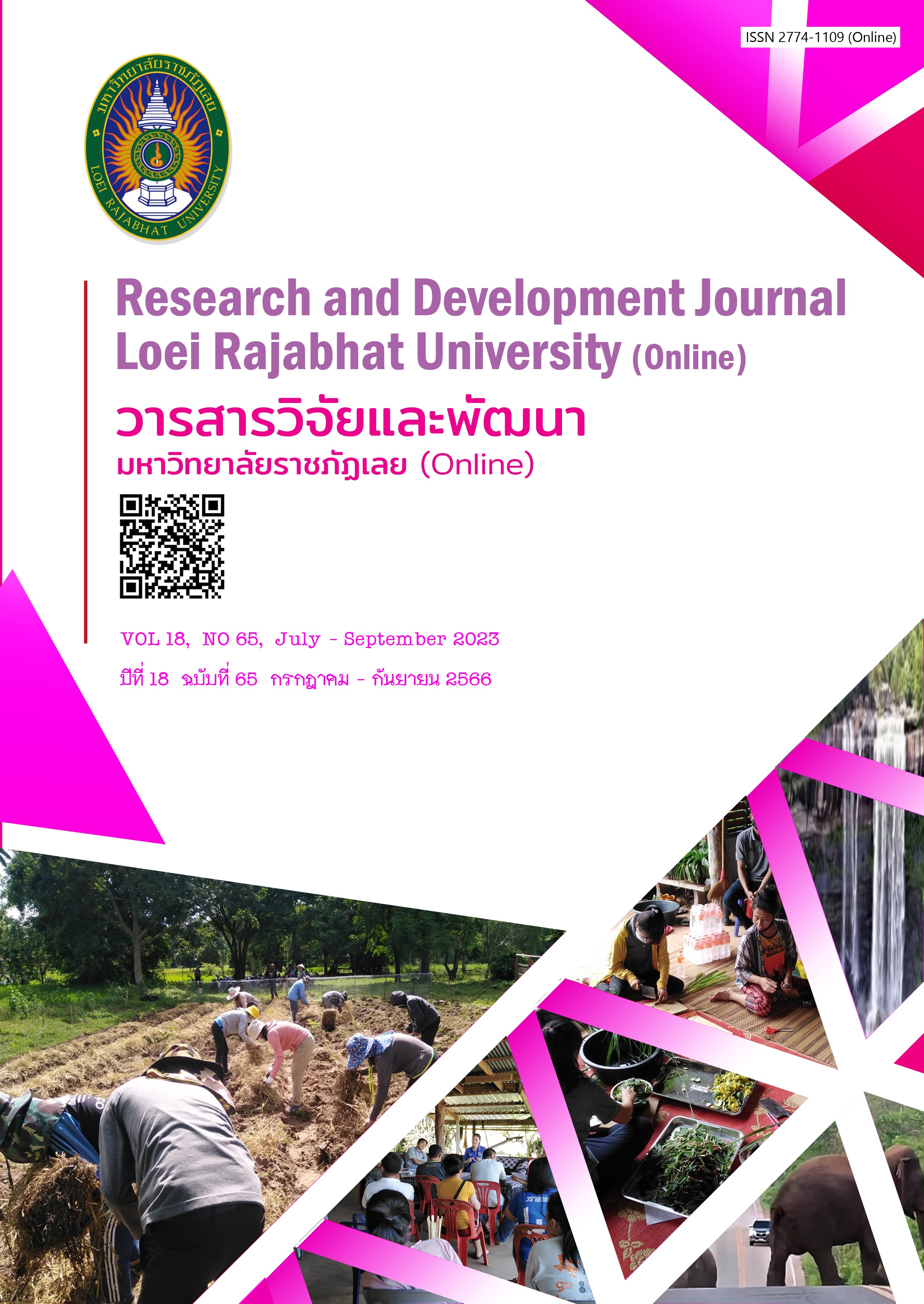Raising the Utilization of Local Medicinal Plants to Enhance the Community Economy: A Case Study of Ban Nong Bua, Bueng Thawei Sub-district, Tao Ngoi District, Sakon Nakhon
Keywords:
community economy, local medicinal plants, raising the utilizationAbstract
This research aimed to study and analyze the situation of local medicinal plant utilization and to develop the increase of the utilization of local herbal resources by using participatory research practice (Participatory Action Research: PAR). The target group was specifically selected for 65 people as community leaders, local experts who had knowledge, a group of growers or producers of herbs, people who were in the income criteria of 40% of the poorest, and users who took advantages from community-level research. The tools used for the community study was in-depth interview and organized group discussions. The results showed that the community produced local medicinal plant situation data sets for utilization which the community could easily access and utilize. There was also an area management model for the cultivation of medicinal plants in rotation and integration in order to reduce market risks relating to the community potential. As a result, the community had increased the area for planting 8 types of medicinal plants (plai, turmeric, turmeric, citronella, aloe vera, agave, okra, and kaffir lime) accounting for 58.53% of the increased target group utilization. There was also an addition of new species and production capacity in the area from the original amount for 30 species. The total planting amount was 754 trees which had been increased to 32 species (citronella and turmeric). The amount of planting after the research project had been carried out was 4,154 trees which was 77.82 percent of the increased utilization in the community.
References
กรมการแพทย์แพทย์แผนไทยและการแพทย์ทางเลือก. (2559). แผนแม่บทแห่งชาติว่าด้วยการพัฒนาสมุนไพรไทย ฉบับที่ 1 พ.ศ. 2560–2564. นนทบุรี: บจก.ทีเอส อินเตอร์พริ้นท์
กรุณา จันทุม และ กัลยารัตน์ กำลังเหลือ. (2560). การรักษาโรคด้วยสมุนไพรและตำรับยาโบราณของหมอพื้นบ้าน. วารสารการแพทย์และวิทยาศาสตร์สุขภาพ, 2(24), 48-57.
ไกรสิทธิ์ สิทธิโชดก, ประทัย พิริยะสุรวงค์, อัญชิตา มาเยอ, พิทพงศ์ สะโง้, ธนพล เฌอมือ และ ภูมิมรินทร์ อยู่ลือ. (2561). รายงานการวิจัยเรื่อง สนับสนุนการพัฒนาระบบสุขภาวะวิถีวัฒนธรรมชาติพันธุ์อ่าข่า จังหวัดเชียงราย (รายงานการวิจัย). กรุงเทพฯ: สํานักงานคณะกรรมการส่งเสริมวิทยาศาสตร์ วิจัยและนวัตกรรม.
ณัฏฐิยา ยอดเอียด, วิชิต เรืองแป้น และ วารุณี หะยีมะสา. (2562). การจัดการพืชสมุนไพรเพื่อความยั่งยืนในลุ่มน้ำและชายฝั่งปัตตานี. วารสารวิชาการมนุษยศาสตร์และสังคมศาสตร์โรงเรียนนายร้อยพระจุลจอมเกล้า, 6(2562), 107-137.
นงลักษณ์ จิ๋วจู, ทิพย์วรรณ ศิบุญนันท์, ชญาน์นันท์ ศิริกิจเสถียร และ วีรวรรณ แจ้งโม้. (2559). การพัฒนาการแปรรูปพืชสมุนไรตามภูมิปัญญาท้องถิ่น จากทรัพยากรความหลากหลายทางชีวภาพเพื่อพัฒนาเศรษฐกิจชุมชน กรณีศึกษา: บ้านโพธิ์พัฒนา ตำบลคณฑี อำเภอเมือง จังหวัดกำแพงเพชร. วารสารวิจัยราชภัฏพระนคร สาขามนุษยศาสตร์และสังคมศาสตร์, 11 (พิเศษ พฤศจิกายน 2559), 83-93.
ปกกสิน ชาทิพฮด, ต่อศักดิ์ เกษมสุข, กันยารัตน์ มะแสงสม, พรรณวดี ศรีขาว, นิโลบล ภู่ระย้า, ญาณิกา แสนสุริวงค์, อารียา วงศ์เตชะ, บา เต้าป้อม, ยูร เต้าป้อม, กิ่งทอง นามวงศ์ชัย, ปัญจา จันทรังษี เเละ วนิสรา วงศ์เตชะ. (2560). การฟื้นฟูภูมิปัญญาการแพทย์พื้นบ้านโดยการมีส่วนร่วมของชุมชนและภาคีเครือข่ายตำบลนาตาล อำเภอเต่างอย จังหวัดสกลนคร. สกลนคร: มหาวิทยาลัยราชภัฏสกลนคร.
สถาบันวิจัยระบบสาธารณสุข. (2560). วิจัยสมุนไพรไทย “คานงัดสู่ความมั่นคงด้านสุขภาพและยั่งยืนด้านเศรษฐกิจ”. สืบค้นจาก https://www.hsri.or.th/researcher/media/news/detail/7491
สามารถ ใจเตี้ย และ ณรงค์ ณ เชียงใหม่. (2560). ปัจจัยทำนายการใช้ประโยชน์พืชสมุนไพรพื้นบ้านของประชาชนลุ่มน้ำลี้ จังหวัดลำพูน. วารสารราชพฤกษ์, 15(3), 70-78.
สำนักงานพัฒนาวิทยาศาสตร์และเทคโนโลยีแห่งชาติ. (2563). โมเดลเศรษฐกิจใหม่ BCG. สืบค้นจาก https://www.nstda.or.th/home/knowledge_post/bcg-by-nstda/
สำนักงานมาตรฐานสินค้าเกษตรและอาหารแห่งชาติ กระทรวงเกษตรและสหกรณ์. (2561). การปฏิบัติทางการเกษตรที่ดีสำหรับพืชสมุนไพร. สืบค้นจาก http://e-book.acfs.go.th/Book_view/298
สุนันทา โรจน์เรืองไร, ไสว มะธิโต, สุมิตรา แกมชัยภูมิ, วิสุทธิ์ เทพภูเขียว และ วีระยุทธ เสนผาบ. (2552). รายงานการวิจัยเรื่อง โครงการฟื้นฟูศรัทธาต่อการรักษาโรคหวัด โรคกระเพาะด้วยสมุนไพรพื้นบ้านของตำบลท่ามะไฟหวาน อำเภอแก้งคร้อ จังหวัดชัยภูมิ (รายงานการวิจัย). กรุงเทพฯ: สำนักงานคณะกรรมการส่งเสริมวิทยาศาสตร์ วิจัยและนวัตกรรม.
อารีกมล ต.ไชยสุวรรณ, วรรณา มังกิตะ, สิริยุพา เลิศกาญจนาพร, สรียา ทรัพย์ศิริ และ ธีราพัฒน์ จักรเงิน. (2560). การวิเคราะห์ต้นทุนและผลตอบแทนการปลูกสมุนไพรของกลุ่มเกษตรกรบ้านหนองสุวรรณ ตำบลบ้านกลาง อำเภอสอง จังหวัดแพร่. วารสารศิลปศาสตร์ มหาวิทยาลัยแม่โจ้, 5(1), 83-96.
Downloads
Published
How to Cite
Issue
Section
License
Copyright (c) 2023 Research and Development Journal, Loei Rajabhat University

This work is licensed under a Creative Commons Attribution-NonCommercial-NoDerivatives 4.0 International License.
ข้อความที่ปรากฎในวารสารฉบับนี้เป็นความคิดเห็นของผู้เขียนแต่ละท่าน สถาบันวิจัยและพัฒนา มหาวิทยาลัยราชภัฏเลย และกองบรรณาธิการ ไม่จำเป็นต้องเห็นด้วยและไม่มีส่วนรับผิดชอบใดๆ
สถาบันวิจัยและพัฒนา มหาวิทยาลัยราชภัฏเลย ขอให้ผู้อ่านอ้างอิงในกรณีที่ท่านคัดลอกเนื้อหาบทความในวารสารฉบับนี้






